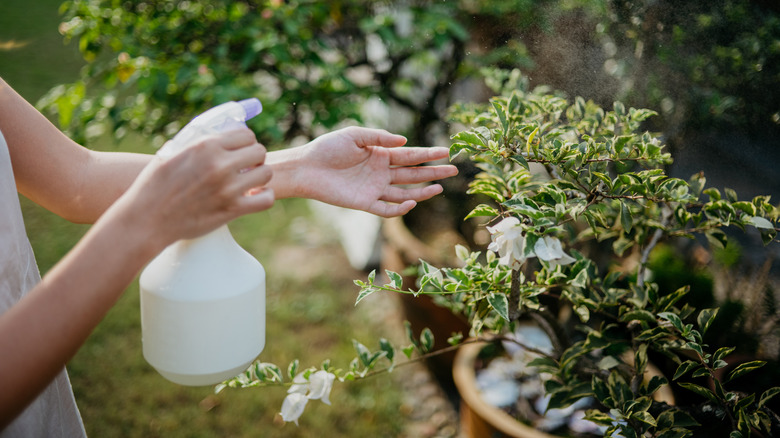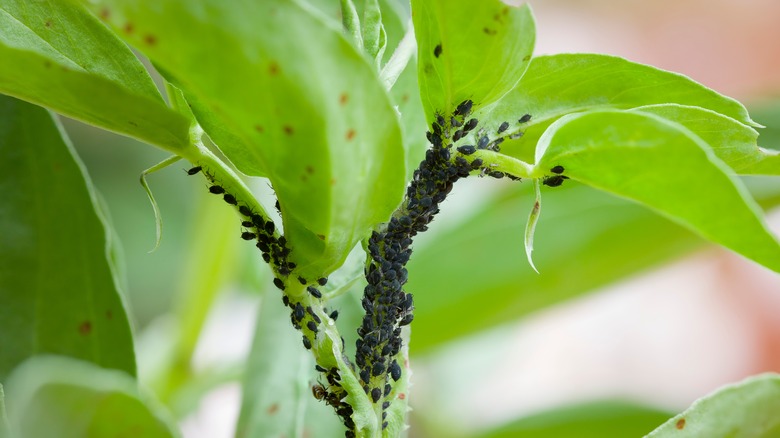Here's How Garlic Can Work As Pest Control In Your Garden
Allium sativum. Garlic. Feared by vampires and loved by cooks, this versatile bulbous flowering plant has earned its reputation as one of the most popular natural preventives and flavors. It has been mentioned throughout various empires in ancient history, from great empires like Rome and Egypt to China and Greece; each has highlighted the value of garlic ... Undoubtedly, it's a pretty popular plant and still increases its fame as we continue to discover more benefits of garlic.
Perhaps to your curious surprise, garlic is also a natural insect repellent. According to Cornell University, it was in the 1970s when scientists began studying the plant's repellent properties and found it to be effective against a variety of pests, such as birds and insects. It's now recognized by the EPA as a low-risk pesticide.
So how does garlic work as pest control in your garden? Well, it works the same way it works on people. Wait... Do insects get bad breath, too? Close, but not quite. It's the smell, and for this reason, insects detest it. This is because of a heroic pairing between sulfur and allicin compounds found in garlic cloves, essentially jamming up their sensory receptors.
How to use garlic as an insect repellent in your garden
The most effective way to use garlic as pest control in your garden is garlic spray — and it's not hard to make. The spray makes for an easy tool as you can add to it and find the best solution for you and your plants. Since there are several different recipes for specific results online, let's just focus on a general garlic gardening spray that will help repel the most common of pests.
What you'll need: one garlic head, water, a blender or fine chopping tool, liquid soap, a fine strainer, a jar, and a spray bottle.
Take a whole head of garlic and peel the cloves from it. Transfer the peeled garlic into a blender with 8 ounces of water. Blend for about a minute until puréed. (If chopping the garlic, chop finely and mix well with water) Then, add 24 ounces of more water, along with 1 ounce of dish soap (ideally, a natural biodegradable kind). Blend again, then transfer to a clean jar. Leave the mixture overnight (about 12 hours). This way, the mixture can become infused with those allicin and sulfur compounds. Once steeped long enough, strain it and remove any solid garlic pieces that may clog up your spray nozzle. Then pour the mixture into a spray bottle and store it in the fridge between uses.
Which pests dislike garlic and how to spot them
It's best to spray your plants in the evening time, about a foot away from the leaves. Try to get both sides of the foilage with an even coating. If you want to keep potential pests away, once-a-week treatment should be enough. However, if you feel that your plants may be infested with a certain pest, repeat this every couple of days and after rainfall.
The spray should successfully keep away several different buggers like aphids, beetles, armyworms, caterpillars, mites, mosquitoes, cutworms, flies, and any larger culprits like mice, moles, rabbits, and deer.
To identify these buggers without having to catch these sneaky pests in the act, look out for marks on your leaves, like holes in the middle or chew marks. Other signs may include leaves curling up or falling off and even yellow spots. All helpful indicators for pests.
And there you have it, garlic– the legendary enemy of vampires, culinary champion, ancient wonder, and now a garden's secret weapon. An all-natural and non-toxic defender in your garden. And the best part? You don't need a degree in horticulture to harness its powers. Just a head of garlic, a splash of water, a hint of dish soap, and a little patience. So, the next time you find your plants are under siege, remember: help is just a garlic spray away. Until then, happy gardening, and may your garlic always be strong!


